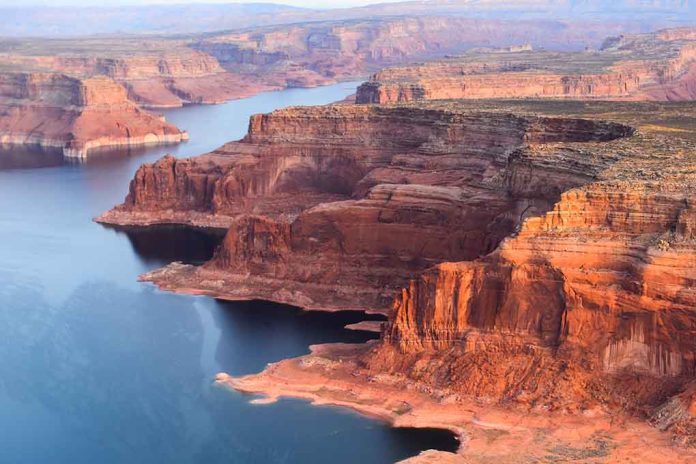
As states grapple over the dwindling Colorado River resources, the federal government’s new management proposals seek to avert a crisis where consensus remains elusive.
At a Glance
- The federal government unveiled potential management strategies for the Colorado River undergoing significant stress.
- Bureau of Reclamation suggests five options including significant water use cuts in affected states.
- The shrinking reservoirs, Mead and Powell, threaten water supplies for millions.
- Management plans are key for communities reliant on Colorado River water starting in 2027.
Federal Intervention in the Colorado River Crisis
The U.S. government has presented five alternative management plans for the Colorado River. These are intended to address the worsening water shortages impacting states in both the Upper and Lower Basins. Key aspects involve keeping more water in Lake Powell and instituting water use cuts in Arizona, California, and Nevada. This move follows failed consensus attempts by the involved states. Strategies will guide new management rules starting in 2027.
Approximately 40 million individuals and various economies depend on the river. However, decreasing storage in key reservoirs like Lake Mead raises alarm about water supply stability. The Bureau of Reclamation’s strategy includes options such as maintaining core infrastructure and sharing shortages based on water rights. Such approaches may secure long-term water availability under increasing demands.
Analyzing New Proposed Management Plans
In December, the Bureau of Reclamation will release detailed analyses of these propositions to identify the most viable solutions. Four of the alternatives are novel, suggesting varied conservation structures and reservoir strategies. Notably, these include a “no action” plan, Alternative 1 resembling current rules, and three others proposing diverse reservation management schemes.
“The alternatives released today will support efforts for all Basin partners to reach consensus on a sustainable path forward,” said John Podesta.
The shrinking flow of this crucial waterway by about 20% since 2000—exacerbated by climate change—calls for urgent solutions. It also evokes the 1922 Colorado River Compact, emphasizing mandatory deliveries from the Upper Basin to the Lower Basin. This historical context underscores the importance of navigating future decisions tactfully among states and Tribal Nations.
State and Indigenous Collaboration
The current divide among the seven basin states, including California’s call to honor long-standing compacts, adds complexity to finding a balanced approach. Each proposal from the federal government aims to overcome disagreements. California emphasizes the importance of adhering to the 1922 Compact stipulations to ensure fair delivery between regions. Meanwhile, state leaders and Indigenous groups strive for collaborative solutions.
With some options factoring in Tribal Nation recommendations and others focusing on conservation efforts guided by environmental groups, the proposals aim to deliver equitable and efficient resource management. The hope is to form a sustainable consensus among basin states and stakeholders, mitigating potential legal disputations and ensuring the region’s vitality.
The Colorado River Basin provides water for more than 40 million people, fuels hydropower resources in seven U.S. states, and is a crucial resource for 30 Tribal Nations. Today, we are providing a durable path forward for its preservation, guided by the incredible @usbr team. https://t.co/qsXgVuwTjS
— Secretary Deb Haaland (@SecDebHaaland) November 20, 2024
Next Steps for Region’s Stability
Looking forward, these management strategies draw attention to crucial regions like Lake Powell, requiring preventive measures to shield essential infrastructure. Opinions conflict over the pro-rata method of water distribution and reservoir directives.
“We continue to support and encourage all partners as they work toward another consensus agreement,” asserted Acting Deputy Secretary of the Interior Laura Daniel-Davis.
The federal government strives to strike a balance that preserves regional ecosystems while meeting anthropogenic demands. Collaborative dialogues among states, Tribal Nations, and conservationists are expected to continue, aiming for amicable and sustainable solutions benefiting all parties.
Sources:
- https://coloradosun.com/2024/11/20/federal-officials-draft-rules-colorado-river-future-management/
- https://www.latimes.com/environment/story/2024-11-20/feds-outline-options-for-shrinking-colorado-river
- https://www.theepochtimes.com/us/federal-government-proposes-alternatives-for-managing-colorado-river-system-5763637










